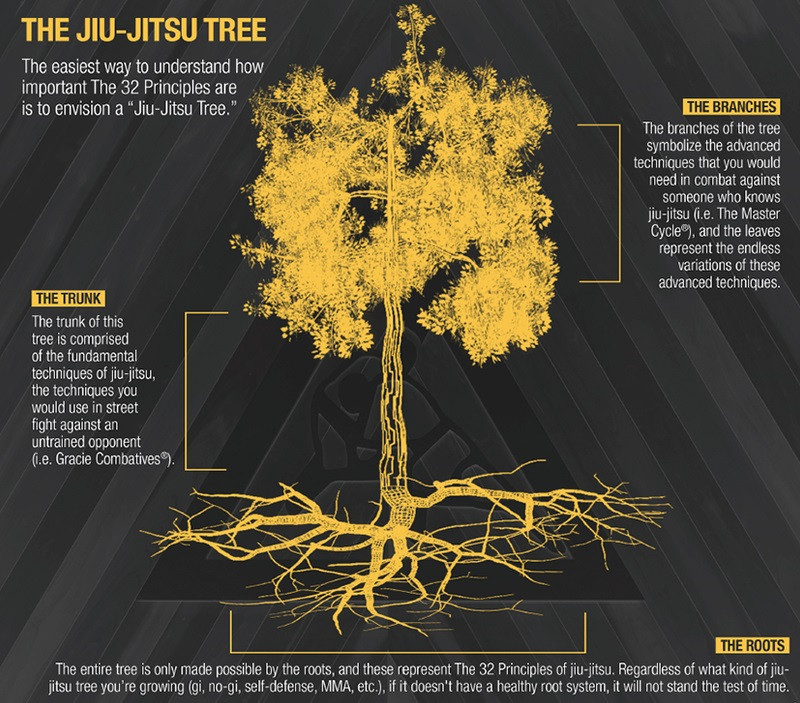The Language & System of Jiu Jitsu
It’s often said that you truly speak a language when you begin to dream in it—when you are literally doing it in your sleep. This is usually the final phase in what can be a very long process of learning a language that can be broken down into three parts. During the first phase, you are simply parroting a few words or phrases. For example, you know that when someone says to you, “Good morning” or “Buenos Dias,” you’re supposed to respond in kind. In the second phase, you still think in your first language, but can then translate it into the new language. You can participate in a conversation, but you often find yourself at a loss for certain words or struggling to keep up with a native speaker. In the third phase, you no longer need to translate; you are ample to think (and dream) in the new language and can converse with anyone else who speaks the language.

This same kind of learning applies to things that aren’t technically languages. It’s not exactly the same, of course, but the principles apply. You begin by copying as you learn the fundamentals. Eventually, you understand the fundamentals well enough so that can think about how to do something the correct way. In the third phase, you get to the point where you don’t even have to think about what you’re doing; it just comes naturally.
In music, for example, you start by copying what your teacher tells you to do—playing a chord or running a scale. Eventually, you get to know enough theory so that you understand how certain chords and keys fit together, but you often can’t do it on the spot. At this point, you might be able to write a song or to take a solo. After years of practice, however, you won’t have to think about what notes to play when improvising. You’ll simply know. At this point, you are effectively thinking in music.
Jiu-Jitsu as a Language
Jiu-jitsu is no different. As a white belt, you learn the basic techniques of the martial art. For several weeks or even months, you are simply doing what your instructor tells you to do. As you progress, you begin to learn how to use those techniques. You begin to think about strategies and how to use certain moves to, for example, escape from mount. At a certain point, however, you stop consciously thinking about how to escape. Your body seems to do it before your conscious mind can even process what’s going on. At this point, you are effectively thinking in jiu-jitsu.
The best jiu-jitsu fighters in the world all have different styles and techniques that they favor, but they all follow the same principles. These principles are based on the same fundamentals—they are the building blocks of the language. As words only make sense if they are used in the proper context (syntax), jiu-jitsu only works as a fighting style if you understand the rules (or theory) that govern it.
Jiu-Jitsu as a System
There are numerous analogies and comparisons to describe this larger system of jiu-jitsu. For example, Matt Thornton, the founder of the Straight Blast Gym, compares the study of jiu-jitsu to a tree in the below video.
As Matt explains, a tree has its roots, its trunk, its larger branches, and then an enormous number of smaller branches and leaves. Without a strong root system, the tree cannot survive. If the roots are strong, but the trunk is not, then it can’t support the boughs and smaller branches. If the tree has a robust root system and sturdy trunk, but only a few healthy boughs, then it cannot support a large network of smaller branches. In other words, the tree’s strength and ability to flourish rests with a strong foundation that starts with its root system, then its trunk, then its boughs. When all three are strong, it has the potential to create an almost limitless web of smaller branches.
The Jiu-Jitsu Tree
For Matt, the analogy translates from roots, trunk, boughs, and branches to base, posture, connectivity, and pressure.
Base
The roots of your jiu-jitsu tree are your base. It is literally your connection to the ground itself. It gives you your center of gravity and allows you to build your posture.
Posture
Your posture is your body’s relationship to your opponent’s body. As Matt says, learning correct posture means learning “the most structurally efficient position you can be in” to give you better leverage to then apply technique.
Connectivity
The next step is to establish the physical connection with your opponent so that you can then apply force or pressure. In the same way that most trees have a relatively small number of boughs, there’s only a few directions or angles where you can successfully apply force or pressure.
Force
As the boughs flow into and branches, and then turn into a seemingly infinite number of leaves, so too does the relatively small number of ways to establish connectivity start to multiply once you begin to explore different techniques, counters, and variations on moves.
Growing Your Jiu-Jitsu Tree
As an instructor, Matt says his goal is to micromanage his students as little as possible. He prefers to focus on teaching the fundamentals of jiu-jitsu, and then giving his students the most possible freedom to figure things out on their own, to decide which variations they like, and to create their own style. This is where individual fighters distinguish themselves and begin to develop personal styles. It’s also when jiu-jitsu is its most fun and becomes the most like a language.

